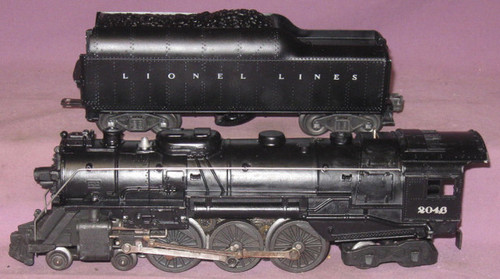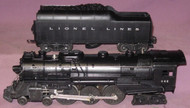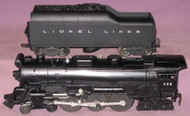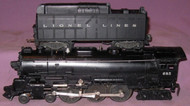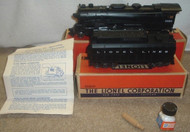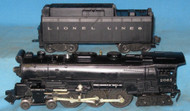- Home
- Motive Power
- Steam
- Hudson
- 2046 Hudson
Product Description
Production: 1950, 1951 & 1953
History
The 2046 steamer was classified by Lionel as a Santa Fe-style Hudson. It's a mid-size steam engine and sold as an 027 gauge item. The 2046 remains a dependable and quality locomotive and is identical to the 646 and 2056 steamer, except for its number. These three locomotives -- the 646, 2046 and 2056 -- are actually a combination of other Lionel steamers: their boilers are from the 736 Berkshire steam engine, but are equipped with the Hudson 4-6-4 wheel arrangement.
Lionel included the 2046 steam engine in five different 027 freight sets between 1950 and 1953 as well as it being available as a separate sale item. Lastly, the 2046 locomotive is a common steamer and was only sold with the 2046W streamlined tender.
Features
Standard features on the 2046 include; 4-6-4 wheel arrangement with detailed driving wheel hardware, black painted die-cast boiler, Magnetraction, three-position E-unit, headlight, smoke, wire handrails plus an ornamental bell.
For 1950 and 1951, the trailing truck was an all die-cast unit. For 1953, the trailing truck was generally the same die-cast version as on the 1950 / 1951 model. However, sometime during the later part of 1953, the trailing truck was changed to the new sheet-metal version with plastic sides. This new style trailing truck was easier and less-costly for Lionel to produce.
Regarding the 2046W tender, the 1950 and 1951 version had thinner and slightly closer spaced lettering. When the 2046W was reintroduced in 1953, the lettering on the side of the tender was a bit thicker and more spaced out along the side.
Additional Detail, Photos & Box Information
The length of the 2046 is approximately 11 1/4" long (front to back).
2046 with early 2046W Lettering - Shown in first photo above. - For the first two years of production, the 2046W tender was produced with thinner side lettering.
2046 with later 2046W Lettering (Second photo above) - For its final production run in 1953, the lettering on the side of the tender is thicker and bolder compared to the 1950 / 1951 version.
 |
 Loading... Please wait...
Loading... Please wait...

